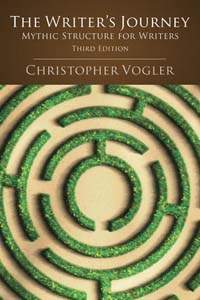By Christopher Vogler

In modern times, especially with the advent of cut-up storylines and out-of-sequence timelines, it may be arguable that, as Vogler asserts, "all stories consist of a few common structural elements found universally in myths, fairy tales, dreams, and movies" especially so given the in-depth use of Star Wars as the basis for this proposition. But without doubt mythic story structure is by far and away the most common form of storytelling used in films, TV and books and it is this combination of the philosophy of Joseph Campbell and the psychology of Carl Jung that Vogler sets out to explain.
The foundations of the book are laid upon two ideas; the first is the idea of character archetypes, The Hero, The Mentor, The Threshold Guardian, The Herald, The Shapeshifter, The Shadow, The Ally and The Trickster. These recurring character types appear in the story, each with a distinct function and each exerting some influence on the Hero but importantly they are also facets of the Hero's personality, parts of himself he will have to deal with, and in recognising and overcoming them the hero will complete his own internal arc. The second is the journey itself which comprises 12 distinct waypoints. the Ordinary World, Call to Adventure, Refusal of the Call, Meeting with the Mentor, Crossing the First Threshold, Tests/Allies/Enemies, Approach to the Innermost Cave, The Ordeal, Reward, the Road Back, Resurrection, return with the Elixir - it is in this part of book that Vogler outlines the blueprint for writing using mythic structure.
This is an excellent book for all writers, but, it has to be said, beginning writers in particular. While the metaphor is that of a journey, this does not literally mean that the Hero goes on a journey – although it might, as in Lord of the Rings or The Wizard of Oz – but rather there are several emotional 'places' in the story the Hero must pass through before reaching the final destination. By mapping out these emotional checkpoints and putting these elements of mythic storytelling into an easily accessible and reusable framework Vogler has crafted the consummate template for the rest of us.
This, the third edition, contains a revised chapter on Star Wars, looking back at the entire epic six-film series with the theme of Father/Son relationships. It also has new illustrations and diagrams that help to deepen the readers understanding of mythic principals and it also contains a new final chapter entitled 'Trust the Path' where Vogler invites the reader to discover themselves through writing by relating a story of how he got lost while hiking – a little self-indulgent maybe but nevertheless interesting.
While Vogler has been criticised in some quarters for creating a template that makes films formulaic, it's down to the individual to use this template as a guide to story structure rather than become a slave to it. What Vogler has given us is a practical manual, one that beginners can use to get themselves a head start down the road and experienced writers can return to when they've strayed from the path and things are not going according to plan, and with that in mind I strongly suggest that if you write then you should have this book on your shelf.
The Writers Journey: Mythic Structure for Writers is published by Michael Wiese Books and is available from Play.com, Blackwell and all good book stores.